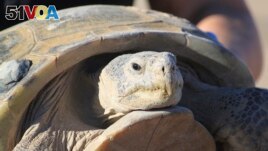08 April 2024
Some of the deadliest diseases to infect humans have come from pathogens that jumped from animals to people. The virus that causes AIDS, for example, came from chimpanzees. And many experts believe the virus that caused the COVID-19 pandemic came from bats.
But, as a new study shows, this disease exchange has not been just from animals to humans. In fact, research of all the publicly available viral genome sequences produced a surprising result: humans give about two times as many viruses to animals than they give to us.
The researchers looked at nearly 12 million virus genomes and found almost 3,000 times a virus jumped from one species to another. Of those, 79 percent involved a virus going from one animal species to another animal species. The remaining 21 percent involved humans. Of those, 64 percent were human-to-animal transmissions. Thirty-six percent were animal-to-human transmissions.

FILE - Gertie, an endangered Bolson tortoise, is shown to a group of state and federal wildlife officials during a trip to Ted Turner's Armendaris Ranch in Engle, N.M., on Friday, Sept. 22, 2023. (AP Photo/Susan Montoya Bryan)
Scientists call the human-to animal transmission anthroponosis. Animal-to-human transmission is called zoonosis.
The animals affected by anthroponosis included pets like cats and dogs; domesticated animals like pigs, horses and cattle; birds such as chickens and ducks; primates such as chimpanzees, gorillas and howler monkeys; and other wild animals like raccoons and the African soft-furred mouse.
Wild animals were more likely to experience human-to-animal transmission than the other way around.
The study represents humans' large "impact on the environment and the animals around us," said Cedric Tan. He is a doctoral student in biology at the University College London Genetics Institute. He was a lead writer of the study, which appeared recently in the publication Nature Ecology & Evolution.
People and animals carry many microbes that can jump to another species through close contact. The study looked at viral transmissions involving all the vertebrate groups: mammals, birds, reptiles, amphibians and fish.
Viruses go between species in the same ways viruses are transmitted between humans, Tan said. That includes "direct contact with infected fluids, or getting bitten by other species, amongst others."
But before the virus enters a different species, it must either have "the biological toolkit, or acquire host-specific adaptations, to enter the cells of the new host species and exploit their resources," Tan added.
Over thousands of years, pandemics that have killed millions of people have been caused by pathogens like viruses, bacteria and fungi that crossed over to people from animals.
Francois Balloux is director of the University College London Genetics Institute and one of the study's co-writers. He said a large majority of pathogens in humans came from animals at some point in time.
"The current biggest threat is probably bird flu H5N1, which is circulating in wild birds," he said. The main reason recent pathogen jumps can be so harmful is because the "population of host species has no pre-existing immunity" to the new disease, he added.
In the 14th century, the bacterial disease bubonic plague killed millions of people in Europe, Asia, the Middle East and North Africa. It was caused by a bacteria normally found in wild rodents.
And present-day diseases like the Ebola virus similarly came from animals.
Most species-to-species transmissions are of little threat, Balloux added.
"In most cases, such infections lead nowhere, as the virus is poorly adapted and there is no onward transmission in the new host," he said.
I'm Dan Novak.
Dan Novak adapted this story for VOA Learning English based on reporting by Reuters.
______________________________________________
Words in This Story
pathogen — n. something such as a type of bacteria or a virus that causes disease
genome — n. the complete set of genes or genetic material present in a cell or organism.
domesticated — n. to breed or train to need and accept the care of human beings
impact — n. the act or force of one thing hitting another
microbe — n. an extremely small living thing that can only be seen with a microscope
vertebrate — n. an animal that has a backbone
toolkit — n. a set of tools, especially one kept in a bag or box and used for a particular purpose.
adaptation — n. the process of changing to fit some purpose or situation
exploit — v. to get value or use from
host — n. an animal or plant in which another animal or plant lives and gets its food or protection